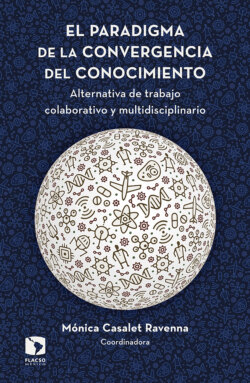Читать книгу El paradigma de la convergencia del conocimiento - Jorge Ernesto Carrillo - Страница 21
На сайте Литреса книга снята с продажи.
Referencias
ОглавлениеAndler, Daniel, Simon Barthelmé, Bernd Beckert, Clemens Blümel, Christopher Coenen, Torsten Fleischer, Michael Friedewald, Christiane Quendt, Michael Rader, Elena Simakova y Steve Woolgar (2008). Converging Technologies and Their Impact on the Social Sciences and Humanities (contecs). An Analysis of Critical Issues and a Suggestion for a Future Research Agenda, Karlsruhe, Fraunhofer Institute for Systems and Innovation Research.
Bainbridge, William (2007). “Converging Technologies and Human Destiny”, Journal of Medicine and Philosophy, vol. 32, núm. 3, pp. 197-216.
Bainbridge, William (2003). “Challenge and Response”, Speech to the World Transhumanist Association's 2003 Haldane Award Banquet, Yale University, 28 de junio.
Balmer, Brian y Margaret Sharp (1993). “The Battle for Biotechnology: Scientific and Technological Paradigms and the Management of Biotechnology in Britain in the 1980s”, Research Policy, vol. 22, pp. 463-478.
Beckert Bernd, Clemens Blümel, Michael Friedewald y Axel Thielmann (2008). “A R&D Trends in Converging Technologies”, en Daniel Andler et al., Converging Technologies and Their Impact on the Social Sciences and Humanities (contecs). An Analysis of Critical Issues and a Suggestion for a Future Research Agenda, Karlsruhe, Fraunhofer Institute for Systems and Innovation Research.
Brooks, Harvey (1994). “The Relationship Between Science and Technology”, Research Policy, vol. 23, núm. 5, pp. 477-486.
Clark, Norman (1987). “Similarities and Differences Between Scientific and Technological Paradigms”, Futures, vol. 19, núm. 1, pp. 26-42.
Diallo, Mamadou, Bruce Tonn, Pedro Alvarez, Philippe Bardet, Ken Chong, David Feldman, Roop Mahajan, Norman Scott, Robert G. Urban y Eli Yablonovitch (2013). “Implications: Convergence of Knowledge and Technology for Sustainable Society”, en Convergence of Knowledge, Technology and Society. Beyond Convergence of Nano-Bio-Info-Cognitive Technologies, Estados Unidos, National Science Foundation, pp. 371-431.
Dibiaggio, Ludovic, Maryam Nasiriyar y Lionel Nesta (2014). “Substitutability and Complementarity of Technological Knowledge and the Inventive Performance of Semiconductor Companies”, Research Policy, vol. 43, núm. 9, pp. 1582-1593.
Dosi, Giovani (1982). “Technological Paradigms and Technological Trajectories: A Suggested Interpretation of the Determinants and Direction of Technical Change”, Research Policy, vol. 11, núm. 3, p. 147-162.
Echenique, Viviana, Clara Rubinstein y Luis Mroginski (2004). Biotecnología y mejoramiento vegetal, Buenos Aires, Ediciones inta.
Faulkner, Wendy (1994). “Conceptualizing Knowledge Used in Innovation: A Second Look at the Science-Technology Distinction and Industrial Innovation”, Science, Technology, & Human Values, vol. 19, núm. 4, pp. 425-458.
Gieryn, Thomas (1995). “Boundaries of Science”, en Handbook of Science and Technology Studies, Londres, Sage, pp. 393-443.
Gutman, Graciela y Pablo Lavarello (2014). Biotecnología industrial en Argentina. Estrategias empresariales frente al nuevo paradigma, Buenos Aires, Gran Aldea Editores.
Hinrichs, Clare (2008). “Interdisciplinarity and Boundary Work: Challenges and Opportunities for Agrifood Studies”, Agricultural Human Values, vol. 5, núm. 2, pp. 209-213.
Jansen, Dorothea (1995). “Convergence of Basic and Applied Research? Research Orientations in German High-Temperature Superconductor Research”, Science, Technology, & Human Values, vol. 20, núm. 2, pp. 197-233.
Joly, Pierre-Benoit y Marie-Angele de Looze (1996). “An Analysis of Innovation Strategies and Industrial Differentiation Through Patent Applications: the Case of Plant Biotechnology”, Research Policy, vol. 25, pp. 1027-1046.
Larsen, Peter Bjørn, Toni Ahlqvist y Karl Friðriksson (2009). Applying Technology Convergence for Innovation in Nordic regions, Oslo, Nordic Innovation Centre (NICe).
Latour, Bruno (1987). Science in Action: How to Follow Scientists and Engineers through Society, Cambridge, Massachusetts, Harvard University Press.
Lundstrom, Mark y Phillip Wong (2013). “Convergence Platforms: Foundational Science and Technology Tools”, en Convergence of Knowledge,Technology and Society. Beyond Convergence of Nano-Bio-Info-Cognitive Technologies, Estados Unidos, National Science Foundation, pp. 133-171.
MacGregor, Donald, Marietta Baba, Aude Oliva, Anne Collins McLaughlin, Walt Scacch, Brian Scassellati, Philip Rubin, Robert M. Mason y James R. Spohrer (2013). “Convergence Platforms: Human-Scale Convergence and the Quality of Life”, en Convergence of Knowledge,Technology and Society. Beyond Convergence of Nano-Bio-Info-Cognitive Technologies, Estados Unidos, National Science Foundation, pp. 72-102.
Mayr, Otto (1976). “The Science-Technology Relationship as a Historiographic Problem”, Technology and Culture, vol. 17, núm. 4, pp. 663-673.
McKelvey, Maureen, Luigi Orsenigo y Fabio Pammolli (2004). “Pharmaceuticals Analyzed through the Lens of a Sectoral Innovation System”, en Sectoral Systems of Innovation. Concepts, Issues and Analyses of Six Major Sector in Europe, Londres, Cambridge University Press, pp. 73-119.
National Research Council (ncr) (2010). Toward Sustainable Agricultural Systems in the 21st Century, Washington, D. C., The National Academies Press.
The Organisation for Economic Cooperation and Development (oecd) (2009). The Bioeconomy to 2030. Designing a Policy Agenda, París, oecd.
Robinson, Douglas (2015). “Distinguishing the Umbrella Promise of Converging Technology from the Dynamics of Technology Convergence”, en Knowing New Biotechnologies: Social Aspects of Technological Convergence, Nueva York, Routledge, pp. 12-25.
Roco, Mihail y William Bainbridge (2003). Converging Technologies for Improving Human Performance: Nanotechnology, Biotechnology, Information Technology and Cognitive Science, Dordrecht, Springer.
Roco, Mihail, William Bainbridge, Bruce Tonn y George Whitesides (2013). Convergence of Knowledge, Technology and Society. Beyond Convergence of Nano-Bio-Info-Cognitive Technologies, Estados Unidos, National Science Foundation.
Sá, Creso y Merli Tamtik (2011). “Structural Genomics and the Organisation of Open Science”, Genomics, Society and Policy, vol. 7, núm. 1, pp. 20-34.
Schmidt, Jan (2008). “Towards a Philosophy of Interdisciplinarity. An Attempt to Provide a Classification and Clarification”, Poiesis Prax, vol. 5, pp. 53-69.
Schummer, Joachim (2004). “Multidisciplinarity, Interdisciplinarity, and Patterns of Research Collaboration in Nanoscience and Nanotechnology”, Scientometrics, vol. 59, núm. 3, pp. 425-466.
Shmulewitz, Ascher, Robert Langer y John Patton (2006). “Convergence in Biomedical Technology”, Nature Biotechnology, vol. 24, núm. 3, pp. 277-280.
Statistics Canada (2005). Biotechnology Use and Development Survey, Science, Innovation and Electronic Information Division, Canadá, Statistics Canada.
Sztulwark, Sebastián (2012). Rentas de innovación en cadenas globales de producción, Provincia de Buenos Aires, Universidad Nacional de General Sarmiento.
Webber, David (1995). “The emerging Federalism of U.S. Biotechnology Policy”, Politics and the Life Sciences, vol. 14, núm. 1, pp. 65-72.
Wield, David, Joanna Chataway y Maurice Bolo (2010). “Issues in the Political Economy of Agricultural Biotechnology”, Journal of Agrarian Change, vol. 10, núm. 3, pp. 342-366.
